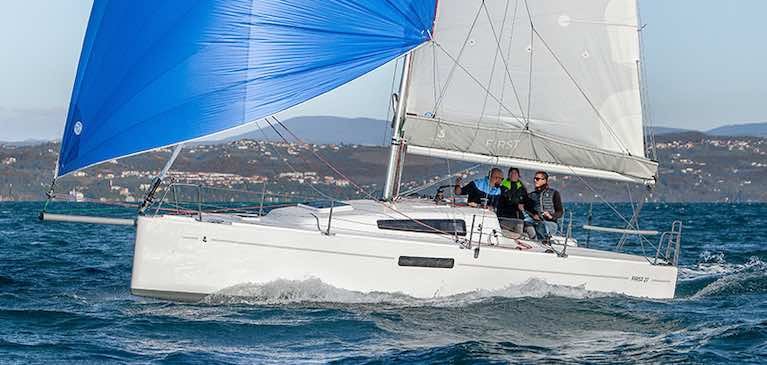Displaying items by tag: First 27
BJ Marine Launch Beneteau's New First Range in Ireland
Beneteau has launched the seventh generation of its First range small sailing cruisers and dayboats under the strapline: "Big boats bring the glory, but small boats make the sailors".
The First 24 and 27 are exciting sports cruisers, while First 14 is an innovative dinghy that brings fun and exciting sailing to everyone.
"We are delighted with the constant evolution and versatility of the First range", Irish Beneteau agent James Kirwan of BJ Marine told Afloat. "BJ Marine has sold more of the current First line up than any dealer in the UK/Ireland and it is definitely reflected in our passion for these boats", he said.
In addition, a new product line of First SE – Seascape Edition, consisting of four models: 14SE, 18SE, 24SE and 27SE, was created. First SE is building on the legacy of Seascape boats and has the mission to bring modern one-design racing and adventure sailing in every sailor's hands.
The ability to specify these boats now for cruising or racing, or a healthy mix of both, makes them ideal for Irish waters and Irish owners as we look to maximise our time afloat and the value we get from our boats, Kirwan told Afloat.
"We see the First 24 and 27 in particular as extremely relevant to domestic racing fleets and we are putting attractive “on the water” packages together for both. We can deliver new boats in time for this season which is fantastic", he said.
Back in the eighties, Beneteau brought the second generation of Firsts to life and with it a wide range of sailing experiences to every kind of sailors. The First range of cruiser-racers answered the needs of those looking to escape to the sea for family holidays or go racing with friends over the weekend. First Class one-design racers offered racing on a level playing field. And on top of that, Wizz, an innovative dinghy designed by studio Finot, opened the door to sailing for everyone.
Forty years later Beneteau and Seascape's joined forces to reinvent the First for the new sailing era defined by accelerated innovation and progress. Focusing on the sailor and the sailing experience, Beneteau and Seascape created two distinct lines, First and First SE – Seascape Edition, to answer the needs of two distinct kinds of sailors.
FIRST 24: THE PERFECT FAMILY DAYSAILER
 The new First 24 from BJ Marine: a fun day-sailor
The new First 24 from BJ Marine: a fun day-sailor
A smart pocket cruiser, fun day-sailor or an exciting club racer all-in-one, she is keeping the First promise of modern performance sailing. She can easily sleep up to 4 persons but at the same time still delivers fun, planning sailing experience. A completely retractable keel gives you access to cruising spots you missed so far and a possibility to launch and recover your 24 on an ordinary slipway, opening new opportunities.
Light and stable hull together with the aluminium rig, classic backstay and Dacron sails make it an ideal weekender and holiday cruiser. The open-space interior is based on huge sleeping surfaces and offers innovative solutions for the toilette, storage, and living space transformation. Winch operated deep composite/lead retractable keel, and removable rudder blades give you access to as little as 30cm of water while keeping the boat fast and stable while sailing.
FIRST 27: AN EIGHT-METER CRUISER FOR THE NEW ERA
 First 27 - A family day sailor
First 27 - A family day sailor
She is the fastest and safest cruiser of her size. First 27 delivers fun and modern planing sailing thanks to modern design and building technologies. Families and couples will love taking her cruising, she will transform a light or strong wind day into a great sailing experience, and she will win trophies on the club races.
Being true to her pocket Yacht description, the 27 offers inboard Yanmar engine, separated Marine toilet, galley, fridge and up to 6 berths. Coachroof and hull windows together with big deck hatches bring a generous amount of light into the saloon while cockpit benches and removable table make living outdoors comfortable. Aluminium rig with classic backstay and dacron sails simplify life with the 27. On the other hand, her striking performance is balanced by a number of safety features, including the deep, 1.7-meter lead fixed keel, twin rudders, and "insubmersibility" volumes, as the French manufacturers describe the new vessel's liability to flooding.





























































